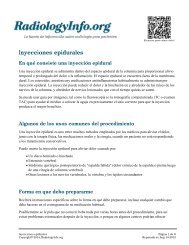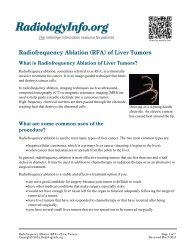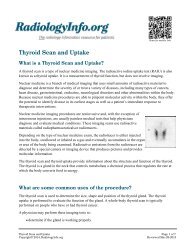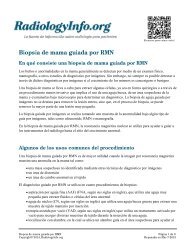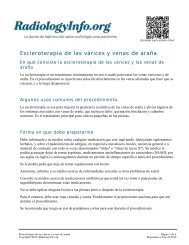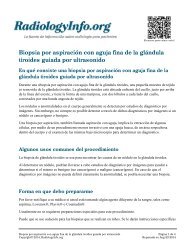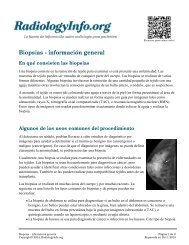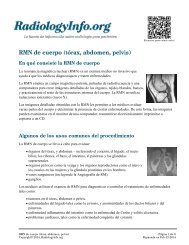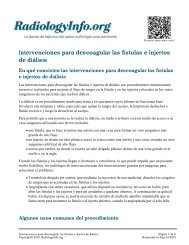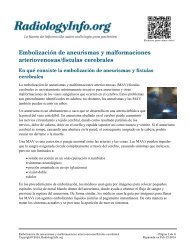Venography - RadiologyInfo
Venography - RadiologyInfo
Venography - RadiologyInfo
You also want an ePaper? Increase the reach of your titles
YUMPU automatically turns print PDFs into web optimized ePapers that Google loves.
adiation. If an x-ray is necessary, precautions will be taken to minimize radiation exposure to the baby.<br />
See the Safety page (www.<strong>RadiologyInfo</strong>.org/en/safety/) for more information about pregnancy and<br />
x-rays.<br />
What does the equipment look like?<br />
The equipment typically used for this examination consists of a radiographic table, one or two x-ray tubes<br />
and a television-like monitor that is located in the examining room. Fluoroscopy, which converts x-rays<br />
into video images, is used to watch and guide progress of the procedure. The video is produced by the<br />
x-ray machine and a detector that is suspended over a table on which the patient lies.<br />
Other equipment that may be used during the procedure includes an intravenous line (IV), ultrasound<br />
machine and devices that monitor your heart beat and blood pressure.<br />
How does the procedure work?<br />
X-rays are a form of radiation like light or radio waves. X-rays pass through most objects, including the<br />
body. Once it is carefully aimed at the part of the body being examined, an x-ray machine produces a<br />
small burst of radiation that passes through the body, recording an image on photographic film or a<br />
special detector.<br />
Different parts of the body absorb the x-rays in varying degrees. Dense bone absorbs much of the<br />
radiation while soft tissue, such as muscle, fat and organs, allow more of the x-rays to pass through them.<br />
As a result, bones appear white on the x-ray, soft tissue shows up in shades of gray and air appears black.<br />
Veins cannot be seen on an x-ray; therefore, a special dye (called contrast material) is injected into veins<br />
to make them visible on the x-ray.<br />
How is the procedure performed?<br />
This examination is usually done on an outpatient basis.<br />
A venogram is done in a hospital x-ray department.<br />
A venogram is performed in the x-ray department or in an interventional radiology suite, sometimes<br />
called special procedures suite.<br />
You will lie on an x-ray table. Depending on the body part being examined (e.g., the legs), the table may<br />
be situated to a standing position. If the table is repositioned during the procedure, you will be secured<br />
with safety straps.<br />
The physician will insert a needle or catheter into a vein to inject the contrast agent. Where that needle is<br />
placed depends upon the area of your body where the veins are being evaluated. As the contrast material<br />
flows through the veins being examined, several x-rays are taken. You may be moved into different<br />
<strong>Venography</strong> Page 2 of 5<br />
Copyright© 2014, <strong>RadiologyInfo</strong>.org<br />
Reviewed Aug-5-2013





